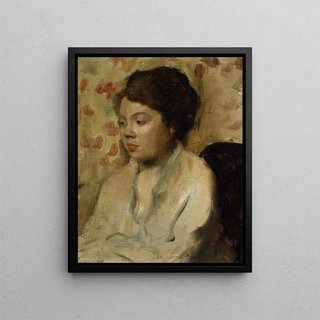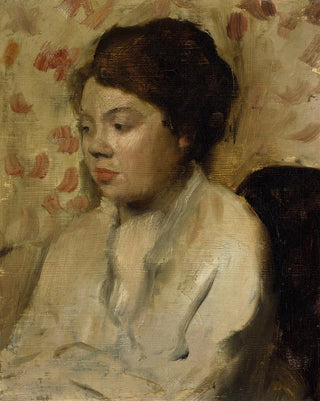Art print | Portrait of a young woman - Edgar Degas Source: Reproduction | Portrait d'une jeune femme - Edgar Degas


View from behind

Frame (optional)
The "Portrait of a Young Woman" by Edgar Degas is a work that captivates with its elegance and psychological depth. This painting, created at the turn of the 20th century, embodies the quintessence of Impressionist style while exploring a more intimate and introspective approach. The young woman, whose face is delicately illuminated, appears frozen in a moment of contemplation, inviting the viewer to share her inner world. Light plays a crucial role in this composition, accentuating the delicate features of her face and creating an atmosphere that is both intimate and mysterious. This portrait is much more than a simple representation; it is an exploration of human emotions, captured through the lens of Degas's artistic sensitivity.
Style and uniqueness of the work
Degas's style in this portrait is distinguished by its ability to blend realism and Impressionism. The artist uses fluid brushstrokes and subtle colors to bring the female figure to life, while maintaining a certain rigor in the facial features. The composition reveals a keen sense of observation, where every detail, from the movement of the hair to the expression in the eyes, contributes to creating a lively painting. Degas excels in capturing fleeting moments, and here, he manages to immortalize a transient emotion, almost ephemeral. The posture of the young woman, slightly inclined, evokes fragility and introspection that resonate deeply with the viewer. This portrait, in essence, is a meeting between beauty and melancholy, an invitation to delve into the soul of his subject.
The artist and his influence
Edgar Degas, an emblematic figure of Impressionism, distinguished himself with his unique approach to human representation and daily life. Although often associated with ballet and dance scenes, Degas also explored portraiture with remarkable sensitivity. His influence is evident in the evolution of modern painting, where emphasis on subjectivity and emotion paved the way for many artists. His ability to capture movement and expression inspired generations of painters, who saw in him a pioneer of modern art. The "

Matte finish

View from behind

Frame (optional)
The "Portrait of a Young Woman" by Edgar Degas is a work that captivates with its elegance and psychological depth. This painting, created at the turn of the 20th century, embodies the quintessence of Impressionist style while exploring a more intimate and introspective approach. The young woman, whose face is delicately illuminated, appears frozen in a moment of contemplation, inviting the viewer to share her inner world. Light plays a crucial role in this composition, accentuating the delicate features of her face and creating an atmosphere that is both intimate and mysterious. This portrait is much more than a simple representation; it is an exploration of human emotions, captured through the lens of Degas's artistic sensitivity.
Style and uniqueness of the work
Degas's style in this portrait is distinguished by its ability to blend realism and Impressionism. The artist uses fluid brushstrokes and subtle colors to bring the female figure to life, while maintaining a certain rigor in the facial features. The composition reveals a keen sense of observation, where every detail, from the movement of the hair to the expression in the eyes, contributes to creating a lively painting. Degas excels in capturing fleeting moments, and here, he manages to immortalize a transient emotion, almost ephemeral. The posture of the young woman, slightly inclined, evokes fragility and introspection that resonate deeply with the viewer. This portrait, in essence, is a meeting between beauty and melancholy, an invitation to delve into the soul of his subject.
The artist and his influence
Edgar Degas, an emblematic figure of Impressionism, distinguished himself with his unique approach to human representation and daily life. Although often associated with ballet and dance scenes, Degas also explored portraiture with remarkable sensitivity. His influence is evident in the evolution of modern painting, where emphasis on subjectivity and emotion paved the way for many artists. His ability to capture movement and expression inspired generations of painters, who saw in him a pioneer of modern art. The "






